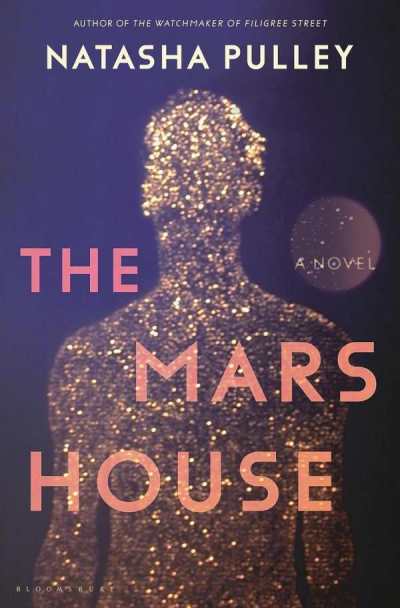Science Fiction-Loving Editor-in-Chief Interviews Natasha Pulley, Author of The Mars House

“The Mariner Valley is my favourite Mars thing. It’s 2500 miles long, and in some places, seven miles deep; unlike our Grand Canyon, which is only a mile deep. What I love about this is that if Mars had an atmosphere like Earth’s, breathable for humans, then the air pressure on the valley floor would be much higher than on the plains; so that’s why I decided to put a city in the base of it. Shielded from the elements, and easier to breathe!’’—Natasha Pulley
Meet Mars. Fourth planet, seventy-eight-million miles more distant from the Sun but half the size of Earth.
Credit the ancient Romans for naming the planet. Noting its red tint, they were reminded of their bloodthirsty god of war, Mars, but that redness is actually caused by the rusting (oxidization) of iron in dirt and rocks on the planet’s surface and dust in the skies. At its most comfortable, temps on Mars can reach 70 degrees Fahrenheit on the planet’s equator. But the Martian atmosphere is so thin, as your toes were enjoying the warmth, the temperature at your head would be 32 degrees.

There is very little doubt that rivers and lakes covered parts of the planet 3.5 billion years ago, which excites the earthlings hoping that life might be lurking in the icy polar regions. Others thrill at the fact that snow falls on Mars. But that aforementioned thin atmosphere is primarily made up of carbon dioxide so rather than fluffy snowflakes, picture dry ice of the type used to create spooky Halloween decorations.
Now, meet the Mars of Natasha Pulley’s imagination, she the author of The Mars House, which earned a starred review from our editorial chief, Michelle Anne Schingler—calling it “a dazzling novel about humanity’s future.”
Enjoy!
I’m curious about the science behind your story, or about how you researched or imagined human life on Mars generations in. For example, is that really what we’d look like?
I don’t know! At the moment, as far as I can tell, a lot of the science is a best guess. Gravity is such a strange thing: we have lots of data about what happens to humans in zero gravity because so many people go to the space station; but really, very little data about what happens in low gravity. Nobody is living on the Moon … or on Mars. There are lots of forecasts about what it would mean for people living there, but in real life, there might be factors we’ve overlooked. So, I looked at some of the information about zero gravity and read articles about how that might affect life on Mars, and gave it my best (non-scientist) guess too.
What Mars fact (or invention of your own!) piqued, or still piques, your curiosity most?
The Mariner Valley is my favourite Mars thing. It’s 2500 miles long, and in some places, seven miles deep; unlike our Grand Canyon, which is only a mile deep. What I love about this is that if Mars had an atmosphere like Earth’s, breathable for humans, then the air pressure on the valley floor would be much higher than on the plains; so that’s why I decided to put a city in the base of it. Shielded from the elements, and easier to breathe!
In part, your novel is about xenophobia—and about the empathy required to overcome it. Can you talk a bit about why January and Gale are such a good pair through whom to explore such issues?
They’re from such different places. January is from Earth, and he’s working class, he works at a factory. Gale is a billionaire technocrat born into a wildly privileged family on Mars. January is British, Gale is a Chinese citizen. Even when the two of them are speaking the same language, they aren’t, really—culture needs as much translation as grammar does, and they both do their best, but sometimes they don’t even know when there’s a translation problem, and those are the moments I was most interested in writing.
In the shoes of January’s contemporaries, would you choose Mars? How about naturalization? What would inform your decisions?
I’d go for Mars: safe, not flooding and not on fire would be the way to go, for me. Like January, I wouldn’t naturalise. Being physically strong is a big part of who I am. I think I’d survive January’s water factory. It’s based on a shipyard I used to work in!
Mammoths on Mars were a delight that it seems no reader can stop raving about. What was the impetus behind their inclusion for you?
I wanted Mars to be in the process of terraforming, so I was researching cold weather species that might be okay in Arctic conditions (Mars is/would be, even if it were terraformed, very cold). Polar bears went in, and then I thought, why not resurrect extinct species too? Mammoth herds would be a great tourist attraction! But also, I wanted something wild, and different to humans, but which could communicate. Something that could show what any thinking things have in common, human or not, and by extension, how little the differences between January and Gale really matter. The mammoths in the story have language: that’s based on real studies done with elephants. I thought that was unbelievably wonderful, so in it went.
I kept hoping against hope that January would dance on Mars, at least once. What do you think he’d need to allow himself the space to do so?
He does dance! He manages some practise sessions toward the middle of the book, but he keeps his distance from anyone who might get hurt. My daydream for his future after the end of the book is that he sets up a new theatre.
Your vision of a new society was inspiring. For example, everyone born on Tharsis is they/them, and it works! Do you think humanity’s future among the stars does have this potential for social betterment, and why?
Definitely: there’s always that potential. Civilisation grinds onwards, and it does mad, spectacular things at every step of the way. There are good times and hard times, massive wealth gaps, revolutions … and there’s art, and love, and stupid multi-lingual jokes at every step of the way too. I think the big reason I’m optimistic is that I’m a university lecturer. I teach undergrads, so most people I know are twenty. And you know what? They’re fantastic. One day, they’re going to be in charge—and it’s going to be fine.
I do properly hope there are talking mammoths, though.
Michelle Anne Schingler
